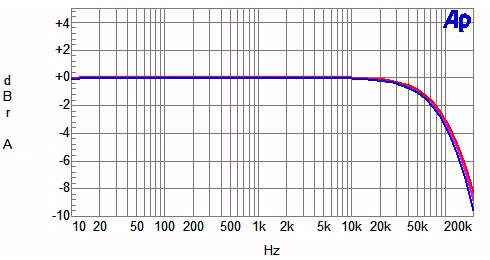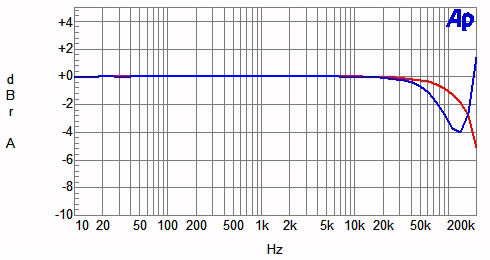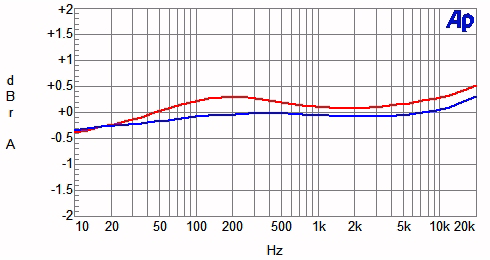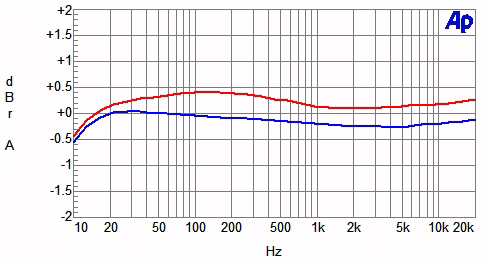|
leslie
- 论坛博士后
- 19720110
- 27155
- 28495
- 2003-01-24
|
27#
t
T
 发表于 2011-04-25 12:32
|只看楼主
发表于 2011-04-25 12:32
|只看楼主
Luxman L-509u Integrated
- Measurements were made at 120V AC line voltage with both channels being driven.
- Measurements were made on the left channel on the unbalanced inputs in the "line-straight" mode unless otherwise noted.
- Input/output polarity
- Unbalanced inputs: non-inverting
- Balanced inputs: inverting
(note: balanced inputs do invert polarity in the "normal" position of the balanced input phase switch as Luxman has defined pin 3 "hot" for their balanced inputs. This is easily changed by pressing the switch to "reverse.") - Phono inputs: non-inverting
- AC line current draw at idle: 1.1A
- Input sensitivity for 1W output into 8 ohms, volume at maximum, Lch/Rch
- Unbalanced inputs: 17.3mV / 17.3mV
- Balanced inputs: 17.5mV / 17.6mV
- Input impedance @ 1kHz
- Unbalanced inputs: 51k ohms
- Balanced inputs: 65k ohms
- Phono MM inputs: 46k ohms
- Phono MC inputs: 100 ohms
- Output impedance at 50Hz: 0.027 ohm
- Gain, output voltage divided by input voltage, volume at maximum, Lch/Rch
- Unbalanced inputs: 163.6X, 44.3dB / 163.2X, 44.3dB
- Balanced inputs: 161.3X, 44.2 dB / 161.1X, 44.1dB
- Phono gain, at 1kHz to tape out
- MM: 59.8X, 35.5dB
- MC: 550.0X, 54.8dB
- Phono overload, input voltage at 1kHz at onset of visual distortion
- Output noise, unbalanced inputs, 8-ohm load, 1k-ohm input termination, Lch/Rch
- Volume control at reference position
- wideband: 2.1mV, -62.6dBW / 2.1mV, -73.9dBW
- A weighted: 0.30mV, -79.5dBW / 0.28mV, -80.1dBW
- Volume control full clockwise
- wideband: 3.8mV, -57.4dBW / 4.0mV, -57.0dBW
- A weighted: 0.20mV, -83.0dBW / 0.23mV, -81.8dBW
- Volume control set for 20dB attenuation below reference
- wideband: 1.7mV, -64.4dBW / 1.7mV, -64.4dBW
- A weighted: 0.18mV, -84.0 dBW / 0.17mV, -84.4dBW
- Volume control full counterclockwise
- wideband: 1.6mV, -65.0dBW / 1.6mV, -65.0dBW
- A weighted: 0.18 mV, -84.0dBW / 0.16mV, -85.0dBW
- Output noise, balanced inputs, 8-ohm load, 1k-ohm input termination, Lch/Rch
- Volume control at reference position
- wideband: 2.1mV, -62.6dBW / 2.1mV, -62.6dBW
- A weighted: 0.31mV, -79.2dBW / 0.29mV, -79.8dBW
- Volume control full clockwise
- wideband: 3.9mV, -57.2dBW / 3.9mV, -57.2dBW
- A weighted: 1.1mV, -68.2dBW / 1.1mV, -68.2dBW
- Volume control set for 20dB attenuation below reference
- wideband: 1.7mV, -64.4dBW / 1.7mV, -64.4dBW
- A weighted: 0.20mV, -83.0dBW / 0.17mV, -84.4dBW
- Volume control full counterclockwise
- wideband: 1.5mV, -65.5dBW / 1.6mV, -65.0dBW
- A weighted: 0.17mV, -84.4dBW / 0.15mV, -85.5dBW
- Phono-referred-equivalent input noise, Lch/Rch
- MM, input 1k-ohm termination resistance
- wideband: 5.8uV / 5.6uV
- A weighted: 0.27uV / 0.28uV
- MC, input 100-ohm termination resistance
- wideband: 0.65uV / 0.69uV
- A weighted: 0.13uV / 0.12uV
Power output with 1kHz test signal
- 8-ohm load at 1% THD: 156.1W
- 8-ohm load at 10% THD: 247.8W
- 4-ohm load at 1% THD: 130.8W
- 4-ohm load at 10% THD: 300.4W
General
A few preliminary points about the measurements. It was found that there was virtually no difference in distortion between the unbalanced and balanced inputs. Therefore, the unbalanced inputs were used for most tests. Also, the performance with the tone and balance controls engaged was about the same as with the Line Straight mode, so the latter was used for testing.
The Luxman L-509u is a medium-power solid-state integrated amplifier. As this unit has a preamplifier line stage within, overall line-input gain of this unit is somewhat high compared to the general current trend in integrated amplifiers, where the gain is generally near power-amplifier-only gain. Still, the gain combination of the L-509u is that of a typical power amplifier -- only gain plus that of a modest-gain line-level preamp -- and that is known to work just fine in practice.
Chart 1 shows the frequency response of the integrated amp with varying loads. This plot was made with the reference volume-control position as set for 0.5V input to produce 5W output into an 8-ohm load. The high-frequency response at the reference setting of the volume control is reasonably wide, having a -3dB point of about 100kHz. Further, the output impedance of the amp is quite low and, therefore, the NHT dummy-load response is not shown, as its variations would not show at the plot's vertical resolution. As is frequently the case, high-frequency response was somewhat a function of volume-control setting, varying from what looks like a higher bandwidth but different response between channels at full volume as shown in Chart 1A, to a more rolled-off response below full volume than in Chart 1, to an almost flat response out to 200kHz at 50dB of attenuation. Bandwidth is widening toward this at -40dB of attenuation, as shown plotted in Chart 1B.
Chart 2 illustrates how total harmonic distortion plus noise vs. power varies for 1kHz and SMPTE IM test signals and amplifier output load. This unit exhibits typical solid-state low-distortion behavior of noise-dominated distortion at low powers, with actual distortion starting to show at powers of about 50W and above.
Total harmonic distortion plus noise as a function of frequency at several different power levels is plotted in Chart 3 for 4-ohm loading. A good result is that the amount of rise in distortion at high frequencies is moderate.
Damping factor vs. frequency is shown in Chart 4 and is of a high value at low frequencies and, as typical of many solid-state power amplifiers, begins to fall off rapidly with frequency at about 500Hz.
A spectrum of the harmonic distortion and noise residue of a 10W 1kHz test signal into 4 ohms is plotted in Chart 5. The magnitudes of the AC-line harmonics are low. Signal harmonics are low, and intermodulation effects of the AC-line harmonics on the signal harmonics are quite absent here.
With the Line Straight button disengaged to allow balance and tone-control use, tone-control characteristics were measured and are shown in Chart 6.
Lastly, RIAA equalization error was measured for both MM and MC modes and is shown plotted in Charts 7A and 7B.
| Chart 1 - Frequency Response of Output Voltage as a Function of Output Loading |
1A
volume control at reference position

Red line: open circuit
Magenta line: 8-ohm load
Blue line: 4-ohm load 1B
volume control full up, 8-ohm load

Red line: open circuit
Blue line: 8-ohm load 1C
volume control -20dB below reference position, 8-ohm load

Red line: open circuit
Blue line: 8-ohm load | Chart 2 - Distortion as a Function of Power Output and Output Loading |

(line up at 20W to determine lines)
Top line: 4-ohm SMPTE IM
Second line: 4-ohm THD+N
Third line: 8-ohm SMPTE IM
Bottom line: 8-ohm THD+N
| Chart 3 - Distortion as a Function of Power Output and Frequency |

4-ohm output loading
Green line: 100W
Blue line: 70W
Magenta line: 10W
Red line: 1W
| Chart 4 - Damping Factor as a Function of Frequency |

Damping factor = output impedance divided into 8
| Chart 5 - Distortion and Noise Spectrum |

1kHz signal at 10W into a 4-ohm load
| Chart 6 - Phono-Stage RIAA Equalization Error |
7A
moving magnet (MM)

Red line: left channel
Blue line: right channel 7B
moving coil (MC)

Red line: left channel
Blue line: right channel | Chart 8 - Tone-Control Response |

Data below 1kHz
Blue line (top): maximum bass boost
Red line: intermediate bass boost
Green line: flat
Magenta line: intermediate bass cut
Blue line (bottom): maximum bass cut
Data above 1kHz
Magenta line (top): maximum treble boost
Blue line (second from top): intermediate treble boost
Blue line (third from top): flat
Light blue line: intermediate treble cut
Green line: maximum treble cut - 测量是在120V交流线路电压均为驱动渠道。
- 测量是在“行直”模式,除非另有说明就关于非平衡输入左声道。
- 输入/输出极性
- 非平衡输入:非反相
- 平衡输入:反相
(注:平衡输入做的“正常”的平衡输入相开关的位置作为Luxman确定了3针“热”的平衡式输入,这是很容易被按下开关来改变极性反转。“反向”。) - 唱机输入:非反相
- 交流线电流消耗在怠速:为1.1A
- 1W输出的输入灵敏度为8欧姆,体积最大,廖创兴/ Rch的
- 非平衡输入:17.3mV / 17.3mV
- 平衡式输入:17.5mV / 17.6mV
- @ 1kHz的输入阻抗
- 非平衡输入:51k欧姆
- 平衡输入:65000欧姆
- MM的唱机输入:46k欧姆
- 管委会唱机输入:100欧姆
- 在50Hz输出阻抗:0.027欧姆
- 增益,输出电压由输入电压,在最大音量分,廖创兴/ Rch的
- 非平衡输入:163.6X,四十四点三分贝/ 163.2X,四十四点三分贝
- 平衡输入:161.3X,44.2分贝/ 161.1X,四十四点一分贝
- 唱机增益,在1kHz到磁带出
- 莫斯利:59.8X,35.5分贝
- 主持人:550.0X,五十四点八分贝
- 唱机过载,输入电压在1kHz发病的视觉失真
- 输出噪声,非平衡输入,8欧姆负载,1K的欧姆输入终端,廖创兴/ Rch的
- 音量控制在基准位置
- 宽带:2.1mV,- 62.6dBW / 2.1mV,- 73.9dBW
- A加权:0.30mV,- 79.5dBW / 0.28mV,- 80.1dBW
- 音量控制旋钮顺时针满
- 宽带:3.8mV,- 57.4dBW / 4.0mV,- 57.0dBW
- A加权:0.20mV,- 83.0dBW / 0.23mV,- 81.8dBW
- 20dB的音量控制设定以下参考衰减
- 宽带:1.7mV,- 64.4dBW / 1.7mV,- 64.4dBW
- A加权:0.18mV,-84.0无国界医生组织/ 0.17mV,- 84.4dBW
- 音量控制逆时针
- 宽带:1.6mV,- 65.0dBW / 1.6mV,- 65.0dBW
- A加权:0.18毫伏,- 84.0dBW / 0.16mV,- 85.0dBW
- 输出噪声,平衡输入,8欧姆负载,1K的欧姆输入终端,廖创兴/ Rch的
- 音量控制在基准位置
- 宽带:2.1mV,- 62.6dBW / 2.1mV,- 62.6dBW
- A加权:0.31mV,- 79.2dBW / 0.29mV,- 79.8dBW
- 音量控制旋钮顺时针满
- 宽带:3.9mV,- 57.2dBW / 3.9mV,- 57.2dBW
- A加权:1.1mV,- 68.2dBW / 1.1mV,- 68.2dBW
- 20dB的音量控制设定以下参考衰减
- 宽带:1.7mV,- 64.4dBW / 1.7mV,- 64.4dBW
- A加权:0.20mV,- 83.0dBW / 0.17mV,- 84.4dBW
- 音量控制逆时针
- 宽带:1.5mV,- 65.5dBW / 1.6mV,- 65.0dBW
- A加权:0.17mV,- 84.4dBW / 0.15mV,- 85.5dBW
- 唱机,称为等效输入噪声,廖创兴/ Rch的
- 的MM,输入1k的欧姆的终端电阻
- 宽带:5.8uV / 5.6uV
- A加权:0.27uV / 0.28uV
- 三菱商事,输入100欧姆终端电阻
- 宽带:0.65uV / 0.69uV
- A加权:0.13uV / 0.12uV
功率输出1kHz的测试信号
- 8欧姆负载,1%总谐波失真:156.1W
- 8欧姆负载为10%总谐波失真:247.8W
- 4欧姆负载,1%总谐波失真:130.8W
- 4欧姆负载为10%总谐波失真:300.4W
一般
关于一些初步的测量点。 结果发现,大致上没有不平衡之间的差异和平衡输入失真。 因此,不平衡的投入被用于大多数测试。 此外,与平衡的基调和从事有关控制性能作为与行,直模式大致相同,因此后者是用于测试。
在Luxman L型509u是一个中等功率固态放大器集成。 由于本单位的前置线阶段内,总体思路,输入本机的增益是有点高比一般的,目前的趋势,即集成放大器的增益一般是近功率放大器只增益。 尽管如此,在L - 509u增益组合,是一个典型的功率放大器 - 只获得一个温和的加增益线路级放大器 - 这是已知能够在实践中就好了。
图1显示了变载荷集成放大器的频率响应。 此图写了与参考音量控制位置为0.5V的输入,以产生为8欧姆负载5W输出设置。 在音量控制设置参考高频率响应范围是合理的,具有的- 3dB点为100kHz左右。 此外,该放大器的输出阻抗非常低,因此,莱科萨斯假负载反应并不显示,因为它的变化不会显示在图的垂直分辨率。 由于经常出现的情况,高频率响应有点的音量控制设置功能,从什么像一个更高的带宽,但不同的反应通道间的最大音量,如在图1a所示的外表,变到更推出过下面的反应全卷图表比1,几乎平坦的响应了在衰减为50dB至200kHz。 带宽是朝这个在-衰减四十○分贝扩大,如绘于图1B所示。
图2说明了总谐波失真加噪声与功率1kHz的测试信号和SMPTE的IM和放大器的输出负载变化。 本单元展示典型的固态低失真行为噪声占主导地位的权力,在低失真,失真的实际出发,以显示在约50瓦及以上的权力。
总谐波失真加作为频率的函数噪声功率水平在几个不同的是在图3所示为4欧姆负载。 一个很好的结果是,在高频率的失真量上升是温和的。
阻尼系数与频率显示在图4和第一个在低频率高值,并为众多的固态功率放大器的典型,开始脱落频率约为500Hz的迅速。
阿的谐波失真和10W的1kHz的测试信号噪声残留为4欧姆谱绘制于图5。 在交流线路谐波的幅度较低。 信号谐波低,对信号的谐波的交流线路谐波互调的影响是相当不存在了。
随着线直按钮脱开,使平衡和音调控制使用,音调控制特性进行了测量,并在图6所示。
最后,美国唱片行业协会,测量误差均衡为MM和MC的模式,并显示在图7A和7B绘制。
以下数据1kHz时
蓝线(上):最大低音增强
红线:中间低音增强
绿线:平
洋红色线条:中间低音切
蓝线(下):最大的低音切 以上数据1kHz时
洋红色线条(上):最大高音增强
蓝线(第二次从上):中间高音增强
蓝线(第三次从上):平
淡蓝色行:中间高音切
绿线:最大高音切
|